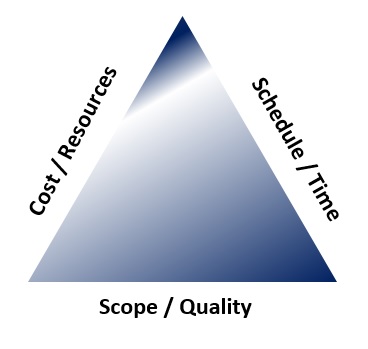
5
JanuaryProject Management
Is the process of leading the work of a team to achieve all project goals within the given constraints. This information is usually described in project documentation, created at the beginning of the development process.
The objective of project management is to produce a complete project, which complies with the client's objectives. In many cases, the objective of project management is also to shape or reform the client's brief to feasibly address the client's objectives. Once the client's objectives are clearly established, they should influence all decisions made by other people involved in the project – for example, project managers, designers, contractors, and sub-contractors. Ill-defined or too tightly prescribed project management objectives are detrimental to decision making.
Project Primary Constraints:
- Scope.
- Time.
- Budget.
- Quality.
- Risk.
- Resources.
Project Management is the application of knowledge, skills, tools, and techniques applied to project activities in order to meet the project requirements. Project management is a process that includes planning, putting the project plan into action, and measuring progress and performance. Managing a project includes identifying your project's requirements; writing down what everyone needs from the project. What are the objectives for your project? When everyone understands the goal, it's much easier to keep them all on the right path. Make sure you set goals that everyone agrees on to avoid team conflicts later on.

In this triangle, each side represents one of the constraints (or related constraints) wherein any changes to anyone-side cause a change in the other sides. The best projects have a perfectly balanced triangle.
Triple constraint triangle:
On any project, you will have a number of competing project constraints that are competing for your attention. They are cost, scope, quality, risk, resources and time...
Cost:
Is budget approved for the project including all necessary expenses needed to deliver the project, within organizations, project managers have to balance between not running out of money and not under spending because many projects receive funds or grants that have contract clauses with a use it or lose it approach to project funds. Poorly executed budget plans can result in a last-minute rush to spend the allocated funds. For virtually all projects, cost is ultimately a limiting constraint; few projects can go over budget without eventually requiring a corrective action.
Scope:
Is what the project is trying to achieve, it entails all the work involved in delivering the projects outcomes and the processes used to produce them. It is the reason and the purpose of the project.
Quality:
Is the standards and criteria to which the project's products must be delivered for them to perform effectively. First, the product must perform to provide the functionality expected, and to solve the problem, and deliver the benefit and value expected of it. It must also meet other performance requirements, or service levels, such as availability, reliability and maintainability, and have acceptable finish and polish. Quality on a project is controlled through quality assurance (QA) that is the process of evaluating overall project's performance on a regular basis to provide confidence that the project will satisfy the relevant quality standards.
Risk:
Is defined by potential external events that will have a negative impact on your project if they occur. Risk refers to the combination of the probability the event will occur and the impact on the project if the event occurs. If the combination of the probability of the occurrence and the impact to the project is too high, you should identify the potential event as a risk and put a proactive plan in place to manage the risk.
Resources:
Are required to carry out the project tasks. They can be people, equipment, facilities, funding, or anything else capable of definition (usually other than labor) required for the completion of a project activity.
Time:
Is defined as the time to complete the project. Time is often the most frequent project oversight in developing projects. This is reflected in missed deadlines and incomplete deliverables. Proper control of the schedule requires the careful identification of tasks to be performed, an accurate estimation of their duration, the sequence in which they are going to be done, and how people and other resources are allocated.
Project Management Methodologies:
Strictly defined combination of logically related practices, methods and processes that determine how best to plan, develop, control and deliver a project throughout the continuous implementation process until successful completion and termination.
Referring to the above-mentioned definition, an appropriately chosen project management methodology paves the way for gaining the following achievements:
- The needs of stakeholders are defined.
- A common “language” is established and understood by the team, so they know what’s expected of them.
- Cost estimates are complete, accurate and credible.
- Every task is done using a common methodological approach.
- Most conflicts are spotted and resolved early.
- Expected deliverables are produced and handed over.
- Lessons are learned and solutions are quickly implemented.
- Project Management Methodologies.
Project Management Methodologies:
1. Waterfall Methodology:The Waterfall method is a traditional approach to project management. In it, tasks and phases are completed in a linear, sequential manner, and each stage of the project must be completed before the next begins.
2. Agile methodology:The concept of agile project management has gone on to spark several specific sub-frameworks and methodologies, such as Scrum, Kanban, and lean.
3. Scrum methodology:Scrum is a form of agile project management. You can think of it more like a framework than as a project management methodology in itself.
With Scrum, work is split into short cycles known as “sprints”, which usually last about 1-2 weeks.
4. Extreme programming (XP) methodology:The extreme Programming (XP) methodology is another form of agile project management that was designed for software development.
5. Lean methodology:Lean is another project management methodology that has its origins in manufacturing (and specifically the Toyota Production System). It’s all about applying lean principles to your project management methods to maximize value and minimize waste.
6. Critical Path Method:The critical path method (also known as critical path analysis) is a way of identifying and scheduling all of the critical tasks that comprise your project, as well as their dependencies.
7. Six Sigma:Six Sigma is a method for improving processes with an emphasis on ensuring consistency in output and impeccable quality.
There are a few different flavors available, such as Lean Six Sigma and Agile Sigma, but ultimately Six Sigma is a business methodology that aims to eliminate defects and reduce variation by using its defined methodologies.
Six Sigma methods can be used to optimize and improve existing processes or create new ones.
is a set of principles and techniques (sometimes it’s even described as a “philosophy”) rather than a project management methodology in itself, Six Sigma methods can be applied alongside many other project management methodologies.
Factors effect on your choice the Right methodology
- Cost and budget.
- Team size.
- Ability to take risks.
- Flexibility.
- Timeline.
- Client/stakeholder collaboration.

Reviews